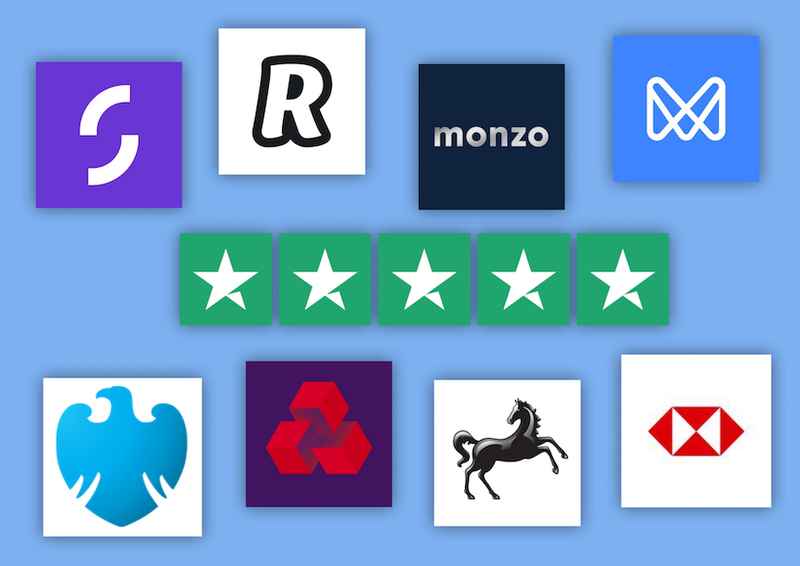Who are the “challenger banks”?
In recent years we’ve seen the rising of the so-called “challenger banks”.
These are, usually, native digital retail banks who exactly challenge the traditional banks, mainly in the retail area of business.
Commonly, they are purely digital, without any physical branch, and all their interactions with the customers are performed online via websites, apps and, eventually, call centres. And they really excel at doing this!
In fact, from a consumer perspective, if we focus on a comparison between the big four traditional banks in UK and four of the top challenger banks, the final result would be a dramatic 4-0 for the latter ones.
The customer reviews comparison.
Let’s take as a reference one of the best rating platforms: Trustpilot.
This platform uses an algorithm based on customers’ reviews of their experience with products and services.
The four challenger banks have all a very high score, with three of them positioning with an “Excellent” rating and one, just below, in the “Great” range of evaluation.

Specifically:
Starling Bank has a rating of 4.5 stars (out of 5) with more than 16,500 reviews;
Revolut scores 4.4 stars with more than 71,000 reviews;
Monzo totalises 4.5 with more than 11,000 reviews;
and Monese scores 4.1 with more than 17,000 reviews (even though we noticed that they have a quite bad score of 1.6 for the Monese.co.uk – which is ranked separately from the Monese.com - but with only 160 reviews, that we could, eventually, sum-up to the other 17k reviews, keeping the total within a quite high score).
On the other side, the big four traditional banks have a very low score, with three of them positioning with a “Bad” rating and one, just a bit better, with “Poor”, clearly not yet sufficient.
More in detail:
HSBC scores 1.4 stars with nearly 4,000 reviews;
NatWest totalises 1.4 stars with just more than 2,500 reviews;
Barclays has a rating of 1.4 stars with more than 4,000 reviews;
and Lloyds is able to reach 1.9 stars with almost 1,400 reviews.
Final considerations.
Summarising, we can notice the huge distance in rating scores, but we can also notice that, in general, the challenger banks are able to get reviewed by a higher number of consumers.
This may happen for different reasons: probably these banks attract customers with a higher digital adoption index, and so, for their intrinsic nature, more prone to review products on digital platforms; but, it’s also probable, that the same challenger banks are more able to stimulate customers to release reviews, with different notifications and requests through their digital applications (and, at the same time, they can afford pushing for reviews, due to the remarkable customer experience they offer).
On the other side, the reasons for the results of the scores depend on multiple factors, but we can probably identify a common denominator: the customer-centric development.
The challenger banks entered this business straight in the digital era, showing an unprecedented digital readiness, and an incredible ability to develop solutions that are perfectly centred around the needs of modern digital customers.
This is where traditional banks are now struggling, and where the competition of retail bankers will reside in the decade to come. It is certainly more difficult for the traditional banks to adjust their historical structures around the digitalisation of the services, but they need to react quickly if they don’t want to lose the battle to keep their leading positions in retail banking.
Maybe for the first time in their life, these organisations are facing a real competition, and they need to be able to do something that they never considered paramount: provide the best customer experience. They are used to request (when not force) the client to adapt itself around the almost immovable structures of traditional banking, but now they need to adapt themselves around the needs of their clients, to offer a smooth and clear customer journey.
In other words, the traditional banks need to undergo the so called “digital transformation”, and deliver it properly and quickly, while the challenger banks don’t need any deep transformation, they are “native digital”, born ready and fit for the current customer type, and they “just” need to stay at the edge of innovation.
To understand how much the latter ones represent a real threat for traditional banks, we can simply consider that they were born all around the year 2015 and in only five years they’ve gained such a considerable market position. Chapeau!
Time is ticking and now it’s up to the big four, if they want to keep the lead.










